 Electrons and Cathode Rays – things rarely pondered
Electrons and Cathode Rays – things rarely pondered
“No man really becomes a fool until he stops asking questions”. – Charles Proteus Steinmetz – See Electron ‘particles’ 2
 Electricity: a Taboo Subject: Physics
Electricity: a Taboo Subject: Physics
Albert Einstein said: “I have now struggled with this basic problem of electricity for more than twenty years, and have become quite discouraged, though without being able to let go of it. I am convinced that a completely new and enlightening inspiration is needed.” Albert Einstein explaining why physicists don’t like electricity and why astronomers call cosmic electricity magnetic fields. There is no “completely new and enlightening inspiration” because it was all pseudo-debunked to make way for particle physics over a hundred years ago.
There is the history of science and technology that never sees the light of day and part of that history is an electrical golden age that ended at a time corresponding with the discovery of the electron, Einstein’s theories and particle physics – such things became permanently embedded within the scientific consensus during the 1930’s. This may seem to be paradoxical but the evidence is here for all to see on this and other pages.
There are serious doubts about the electron, cathode rays and the research that led to the “discovery of the electron”, not to mention doubts about the stuff we read in textbooks. The history of electrical research is a taboo subject in academic scientific circles. This may also appear to be a paradox but science is well-stocked with paradoxes. Those who have a genuine interest in putting the record straight would do well to read Eric P Dollard : See: Eric Dollard in Books and Doc’s

The Cathode Ray Tube (CRT)
The original cathode ray tube (right) of Michael Faraday and others was a tube with a cathode at one end and an anode at the other, following faithfully the basic ideas of electronics giving a simple circuit of minus to plus. The electrons (we are told) enter the tube through the cathode and proceed to the anode and then back to the electrical source … Ta Dahhhh we have an electrical circuit. But it doesn’t always work that way…
CRT Anode Strangeness
As people like William Crookes and J.J. Thomson experimented with cathode rays they moved the anode to various places on the tube, unlike the straightforward Faraday tube above. If we Google some graphics we find that in some the anode is to the side in its own extended tube (see below). Any flow of particles/rays/electrons would need to bend into it to form a circuit. Remember, we are speaking of cathode rays that we are told move in a straight line. In others the anode is close to the cathode with a hole in it’s centre to allow the cathode rays to pass through it. (There is no discussion about all of this that I’ve been able to find) The main feature in Thomson’s experiments was the deflection of the cathode rays, but it is never mentioned that the strongest attraction (If we are dealing with electrons) should rightly come from the anode. Looking at the experiments there seems to be little or no attraction of the negative cathode rays toward the positive anode. This is what intrigues me.

We are told that cathode rays move in a straight line. So what is it that is curving into the anode tube? It should be the electrons but if cathode rays are electrons they are not supposed to go around corners?



Cathode Ray Deflection
Thomson (and several others in a true history) had to insert two plates within the tube, with a positive and negative charge, in order to deflect the rays. https://en.wikibooks.org/wiki/High_School_Chemistry/Further_Understanding_of_the_Atom
I would love to hear a plausible explanation as to why this setup so easily deflects cathode rays with a lower voltage and the high voltage anode, marked with a plus to the left does not do so?


JJ Thomson was unsure as to what the cathode rays were and assumed that they were as a result of the tenuous gas left in the tube after evacuation. But later when vacuum tube diodes and triodes began to be manufactured it was found that they were more efficient with a hard vacuum and so it was not Thomson’s gas.
The only logical answer to the questions posed above is that there are two different types of electricity flowing in a cathode ray tube and that electrons as we know them do not exist.
Electrons?
Another question is where do the electrons come from? We are told by Wiki that electrons move very slowly, if at all: “Free electrons in a conductor follow a random path. Without the presence of an electric field the electrons have no net velocity. When a DC voltage is applied, the electron drift velocity will increase in speed proportionally to the strength of the electric field. The drift velocity is on the order of millimeters per hour. AC voltages cause no net movement; the electrons oscillate back and forth in response to the alternating electric field over a distance of a few micrometers…”
https://en.wikipedia.org/wiki/Speed_of_electricity#Electric_drift
So why does the cathode not become depleted of electrons? Where do the electrons come from if they are hardly moving?
The theory of ‘push electrons’ (below) becomes untenable when we consider that a current can flow in both directions at the same time in the same conductor.
The rationalisation of the impossible!
allaboutcircuits.com says: “A noteworthy observation may be made here. As each electron moves uniformly through a conductor, it pushes on the one ahead of it, such that all the electrons move together as a group. The starting and stopping of electron flow through the length of a conductive path is virtually instantaneous from one end of a conductor to the other, even though the motion of each electron may be very slow. An approximate analogy is that of a tube filled end-to-end with marbles:
allaboutcircuits.com: “The tube is full of marbles, just as a conductor is full of free electrons ready to be moved by an outside influence. If a single marble is suddenly inserted into this full tube on the left-hand side, another marble will immediately try to exit the tube on the right. Even though each marble only traveled a short distance, the transfer of motion through the tube is virtually instantaneous from the left end to the right end, no matter how long the tube is. With electricity, the overall effect from one end of a conductor to the other happens at the speed of light: a swift 186,000 miles per second!!! Each individual electron, though, travels through the conductor at a much slower pace.”
There is absolutely no evidence that electrons are close enough to behave in this way let alone in a straight line pushing each other. Electrons are said to have a negative charge that should cause them to repel each other.
Best Answer Yahoo Answers: “So, finally, for your question. Electron-electron repulsion occurs between any two electrons in the atom. The amount of repulsion depends on the distances between them. “
https://answers.yahoo.com/question/index?qid=20081127005333AAyUoZU
And so we must assume that touching electrons have maximum repulsion.
The next diagram says something completely different: The centre conductor in this circuit cannot be a tube of marbles as the marbles would be moving in opposite directions at the same time whilst also repelling each other. I suggest the sceptic gets him/herself the cheap and simple components below and personally carries-out the experiment. This is quite important as it will blow the physicists out of the water and bring about a more balanced, less religious approach to physics.

The idea that a current can flow in multiple directions has been known about for a very long time. The chassis (the metal box that the components sit on) as used in old radios and TV’s had currents AC and DC flowing in all directions at the same time, contrary to the expectations of the push-marble theory. The push-marble theory would have been laughed to scorn 40 years ago because everyone could observe the error in radios that were in every home.

It ain’t what you don’t know that counts.
It’s what you know that ain’t so.
– Will Rogers
The idea that electrons are marbles in a tube derives from scientific atomism that has roots in ancient Greece. Science has to idealise everything as being particles to support its materialistic philosophy. Nikola Tesla shorted out his power supply (below) and still managed to have a *something* flowing into his coils as shown at “output” below.
Electricity is energy… a moving field of energy.
 It’s important to note that he used a pulsed DC input. The red line shows his deliberate short circuit. The output is the *something else* like electricity but not electricity, streamers and rays felt on his skin from the the secondary coil. Several experimenters of Tesla’s day and some more recent researchers have discovered this and they call it “cold electricity”. See Eugene Mallove below
It’s important to note that he used a pulsed DC input. The red line shows his deliberate short circuit. The output is the *something else* like electricity but not electricity, streamers and rays felt on his skin from the the secondary coil. Several experimenters of Tesla’s day and some more recent researchers have discovered this and they call it “cold electricity”. See Eugene Mallove below
See more @: The Free Energy Secrets of Cold Electricity by Peter A. Lindemann, D.Sc.
 All of this is of course completely ignored by mainstream science and true to form it chose the particle physics route. Science likes particles and the electron became the first of many, giving birth to the science of particle physics. The electron most probably does not exist, but particle accelerators continue to find ever smaller enigmatic particle results that will contribute nothing to the sum of useful or usable knowledge. There will never be, and there has never been, any usable or generally useful technology arising from particle physics. A challenge to the reader to find one – on sale – in the shops! Find one and make me look foolish… ‘But of course there has to be technology arising from modern physics… so why bother to look for it’?
All of this is of course completely ignored by mainstream science and true to form it chose the particle physics route. Science likes particles and the electron became the first of many, giving birth to the science of particle physics. The electron most probably does not exist, but particle accelerators continue to find ever smaller enigmatic particle results that will contribute nothing to the sum of useful or usable knowledge. There will never be, and there has never been, any usable or generally useful technology arising from particle physics. A challenge to the reader to find one – on sale – in the shops! Find one and make me look foolish… ‘But of course there has to be technology arising from modern physics… so why bother to look for it’?
Historical Electronics
It must also be noted at this point that a basic version of all of today’s electronics was available at the time the electron discovery took place. Had this not been the case JJ Thomson could not have carried-out his experiments. All of the circuitry and the electronic components we have today were present in a basic form. Even the transistor was documented around 1910. Notwithstanding the original circuits worked perfectly well with transistors as they did with the original components. Today we have a transistorised, miniaturised version of the old technology. This is the paradox mentioned at the start of this page: The golden age of electronic discovery ended with the introduction of the electron.

The Nobel Prize in Physics 1906 was awarded to J.J. Thomson
Not for the discovery of the electron but for: “the great merits of his theoretical and experimental investigations on the conduction of electricity by gases” https://www.nobelprize.org/nobel_prizes/physics/laureates/1906/
“To the electron — may it never be of any use to anybody.” — JJ. Thomson’s favorite toast
It may come as a surprise to some but Thomson was well aware of all of the above, hence the quote. He was a firm supporter of the aether theory and his research was along the same lines as Nikola Tesla and Charles Steinmetz. Steinmetz is documented as saying that ‘the electron is a childish idea’ and Tesla said it did not exist. Both men were at the very pinnacle of electronic research and development in their day and academic scientists were eager to attend their lectures. Unlike today.

From the late Eugene Mallove:
In an elaborate series of experiments with Tesla coils, employing a host of different thermal and electric sensing apparatus (mercury thermometers, electroscopes, GM counters, oscilloscopes, neon bulb indicators within circuitry, Faraday cages, and plate antennas) at different ranges from the coil tips, and using comparison energy sources (various ion generators and radioactive sources), the Correas were able to rule out what Tesla coil radiation is not, and to synthesize what it may well be. They conclude that Tesla coils emit a special form of mass-free radiation that is not electromagnetic in character and not sourced in ionic emissions. They observed that these “Tesla waves alone were capable of triggering the ratemeter via the plate antenna even at substantial distances.” They suggest that the pulsed input to the primary of the Tesla coil “induces in the space of the closely coupled secondary a conversion of the local aether energy to electric form.”
They write, “All happens as if these coils synthesized two different kinds of electric fields, one proximal [near the coil] and mass_bound, and the other mass-free and responsible for all distal [distant from the coil] effects.”
At root, these experiments touch on the deep issue of the aether and its relation to what are evidently two basic forms of electricity, the accepted form (massbound, the flow of electrons), and other not accepted at all by conventional science, massfree—capable of flowing in and around wires, as well as being transmitted as Tesla waves through gas media and vacuum.
The mass-free form of electricity might be called “cold electricity.” This hearkens back to another fundamental issue, the very nature of some non-standard biological energies, which are also presumed not to exist and the subject of much mockery these day.
Read it all here: http://aetherforce.com/tesla-the-aether-by-eugene-mallove/
So deep-rooted in our consciousness is the idea of the electron that it becomes all but impossible to imagine a world without it. We know it did not come from Thomson; from whence did it come?
And Dr. Jobard
In 1856 Dr. Jobard of Paris declared to a startled press: “I hold a discovery which frightens me. There are two kinds of electricity; one, brute and blind is produced by the contact of metals and acids; the other is intelligent and clairvoyant. The brute (one) …has followed Jacobii, Bonelli, and Moncal, while the intellectual one was following Bois-Robert, Thilorier, and Chevalier Duplanty. The electrical ball or globular electricity (ball lightning?) contains a thought which disobeys Newton (gravity?) and Mariotte (?) to follow its own freaks…. we have in the annals of the academy thousands of proofs of the intelligence of the electric bolt…but I remark that I am permitting myself to become indiscreet. A little more and I would have disclosed to you the key which is about to discover to us the universal spirit.”
http://www.anomalist.com/features/forgotten.html
For a typical example of just how unnecessarily complex electronics theory has become as a result of the introduction of the electron see the page:
Conventional Versus Electron Flow
The “Conventional” is how the flow of electricity was visualised before the electron and “Electron Flow” is how it was visualised after the electron was conceived. Both are still in use thanks to particle physics.

Thanks for these very interesting article!
We are regressing day by day with regard to real technological advancement and this is disguised by all crap gadgets that they push to us.
LikeLiked by 1 person
Thank you Andre
LikeLike